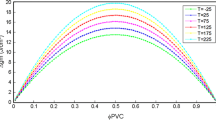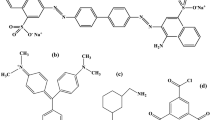Abstract
Cellulose acetate (CA) membranes are widely used for ultrafiltration applications. CA and poly (vinyl chloride) (PVC) blend membranes are prepared by using polar solvent of N, N-dimethylformamide (DMF) by phase inversion method. Polyethylene glycol (PEG 600) is used as polymeric additive in the casting solution. The effect of polymer composition and additive concentration on surface morphology, porosity are studied. The morphology of prepared membranes is found to have asymmetric structure with dense skin layer and porous sub-layer. Applications of these membranes are carried out for rejection and permeation of macromolecular proteins such as trypsin, pepsin, egg albumin, bovine serum albumin. On increasing the concentration of PVC and PEG 600, protein rejection decreases whereas permeate flux increases.CA/PVC/PEG (70/30/10 wt%) blend membrane shows the highest permeation flux of 211.1 lm−2 h−1 for trypsin.





Similar content being viewed by others
References
Pollution prevention and abatement hand book (1998) Dairy Industry World Bank, p 295
Haitao Z, Chengyao W, Yunlong Z (2010) J Mater Sci 45:2296. doi:10.1007/s10853-009-4191-3
Iritani E, Mukai Y, Murase T (1995) Sep Sci Technol 30:369. doi:10.1080/01496399508013877
Chan R, Chen V, Bucknall MP (2002) Desalination 146:83. doi:10.1016/S0011-9164(02)00493-9
Granja PL, Barbosa MA, Pouys L (2001) J Mater Sci 36:2163. doi:10.1023/A:1017587815583
Hayama M, Yamamoto K, Kohori F et al (2004) J Membr Sci 234:41. doi:10.1016/j.memsci.2004.01.020
Qin JJ, Li Y, Lee LS, Lee H (2003) J Membr Sci 218:173. doi:10.1016/S0376-7388(03)00170-4
Nowak KM, Kowalska I, Korbutowicz MK (2005) Desalination 184:415. doi:10.1016/j.desal.2005.02.057
Yellin N, Zelingher N, Ben-Dor L (1986) J Mater Sci 21:504. doi:10.1007/BF01145515
Xiaoyu H, Changfa X, Shulin A, Guangxia J (2007) J Mater Sci 42:6234. doi:10.1007/s10853-006-1107-3
Brousse Cl, Chapurlat R, Quentin JP (1976) Desalination 18:137. doi:10.1016/S0011-9164(00)84098-9
Yang T, Sun B, Li W (1995) First Membrane Industry report Meeting, Membrane industry association of China, Beijing, p 190
Ramesh Babu P, Galker VG (2000) Appl Polym Sci 77:2606. doi:10.1002/1097-4628(20000919)
Peng Y, Sui Y (2006) Desalination 196:13. doi:10.1016/j.desal.2005.07.053
Karus MA, Nemas M, Frommer MA (1979) J Appl Polym Sci 23:445. doi:10.1002/app.1979.070230214
Boom RM, Wienk IM, Boomgaard T et al (1992) J Membr Sci 73:277. doi:10.1016/0376-7388(92)80135-7
Wienk IM, Boom RM, Beerlage MAM et al (1996) J Membr Sci 113:361. doi:10.1016/0376-7388(95)00256-1
Jimenez DBM, Narbaitz RM, Matsuura T et al (2004) J Membr Sci 231:209. doi:10.1016/j.memsci.2003.11.026
Yeo HT, Lee ST, Han MJ (2000) J Chem Eng Jpn 33:180. ISSN: 0021-9592
Arthanareeswaran G, Thanikaivelan P, Srinivasn K et al (2004) Eur Polym J 40:2153. doi:10.1016/j.eurpolymj.2004.04.024
Munari S, Botino A, Camera-Roda G et al (1990) Desalination 77:85. doi:10.1016/0011-9164(90)85022-3
Saljoughi E, Sadrzadeh M, Mohammadi T (2009) J Membr Sci 326:627. doi:10.1016/j.memsci.2008.10.044
Coleman MM, Graft JF, Painter P (1991) Miscible polymer blends. Technomic Publishing, Lancaster. http://pslc.ws/macrogcss/blend.html
Kim JH, Lee KH (1998) J Membr Sci 138:153. doi:10.1016/S0376-7388(97)00224-X
Dunweg G, Lother S, Wolfgang A (1995) US Patent 5, 403, 485
Kim IC, Lee KH (2004) J Membr Sci 230:183. doi:10.1016/j.memsci.2003.11.002
Arthanareeswaran G, Latha CS, Mohan D et al. (2006) Sep Sci Technol 41: 2895. doi:10.1080/0149390600786192
Brinck J, Jonsson AS, Jonsson B et al (2000) J Membr Sci 164:187. doi:10.1016/S0376-7388(99)00212-4
Mukai Y, Iritani E, Murase T (1998) Sep Sci Technol 33:169. doi:10.1080/01496399808544762
Author information
Authors and Affiliations
Corresponding author
Rights and permissions
About this article
Cite this article
Krishnamoorthy, L., Arif, P.M. & Ahmedkhan, R. Separation of proteins from aqueous solution using cellulose acetate/poly (vinyl chloride) blend ultrafiltration membrane. J Mater Sci 46, 2914–2921 (2011). https://doi.org/10.1007/s10853-010-5166-0
Received:
Accepted:
Published:
Issue Date:
DOI: https://doi.org/10.1007/s10853-010-5166-0




